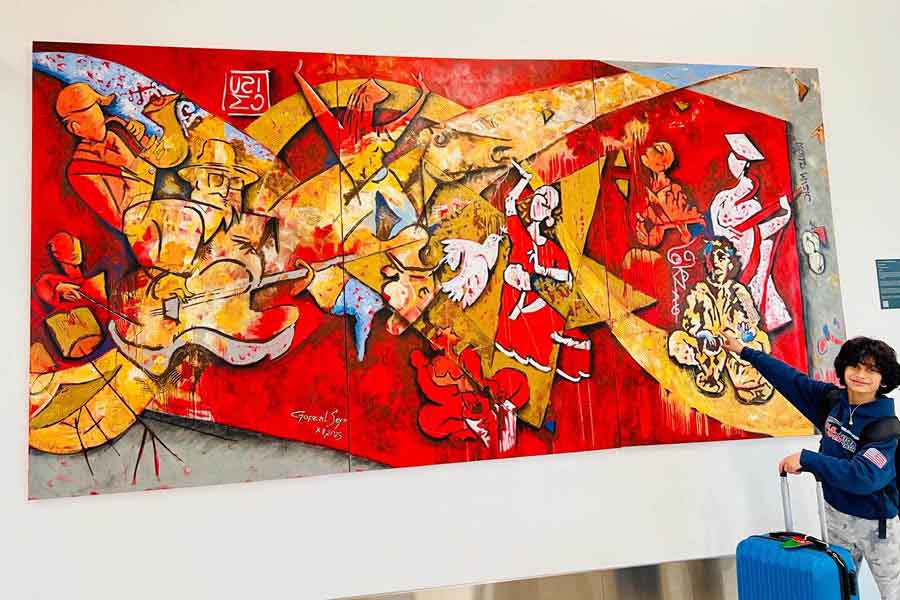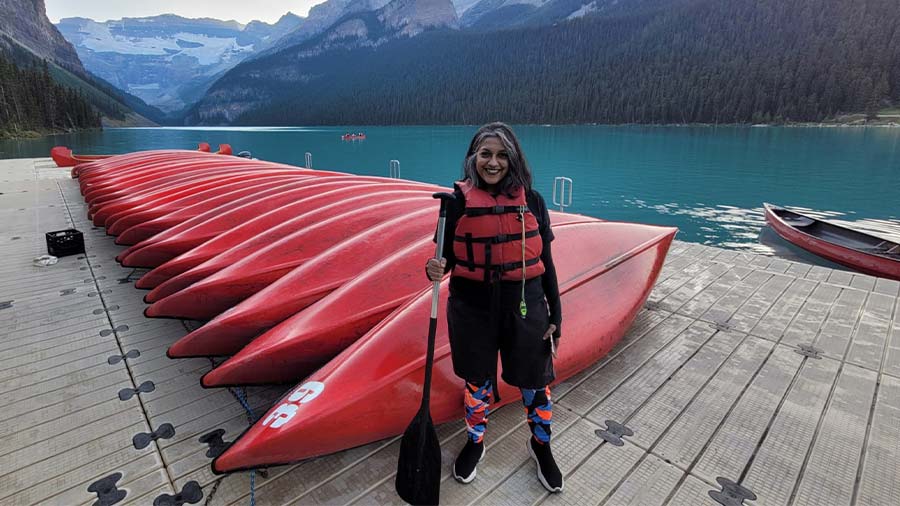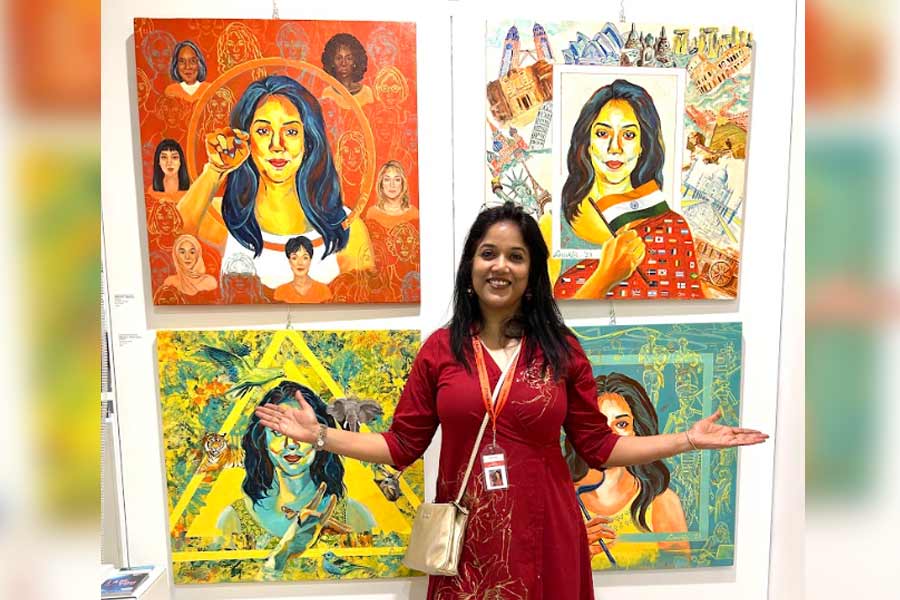Gopaal Seyn wakes up at 4.30am every morning, almost three hours before the March sun rises in Houston, Texas, where he has been based since the early ’90s. After meditating for 30 to 45 minutes, he calls up his mother, Anuradha Sen, “my positive force and inspiration” back in Kolkata, before he starts painting. Seyn paints at least two to three pictures every day for five to six days every week. He painted more than 3,700 pictures during the pandemic alone. As he paints, Seyn often texts the parents of his students at the RedBlueArts Academy (in Sugar Land, Texas) to remind them of the supplies they need to arrange for their kids. Seyn has over 125 students attending his classes in person, with more than 150 learning online. His students, who often join as young as five or seven years, range from Indians, Pakistanis and Chinese to African-Americans as well as Caucasians. Seyn’s sessions are not limited to youngsters, though, with many adults, including a few septuagenarians, also attending.
In the time it has taken you to read the paragraph above, Seyn can complete a sketch worth thousands of dollars. “All great creation happens in a spark,” says Seyn, 58, speaking to My Kolkata over a video call from Houston. Born and brought up in Bowbazar, Seyn studied hotel management at the Institute of Hotel Management (IHM) in Taratala before moving to the US for his MBA in hospitality and administration from Johnson & Wales University in Providence, Rhode Island. “I never thought I’d be an artist when I came to the US,” admits Seyn, who was as far from art as he was from his hometown when he took up a “few odd jobs” en route to joining the InterContinental Hotels Group. Seyn spent a little over two decades in hotel management, overseeing food and beverages. “I loved my life, including travelling and meeting people… but I didn’t want to die with music inside,” says Seyn, for whom art was a lifelong passion.
‘I converted my garage into a studio and painted from 6am to 10.30pm’

One of Seyn’s paintings finds pride of place at the George Bush Intercontinental Airport in Houston. Gopaal Seyn
“If I had to be an artist, I had to cover my bases. I had to be practical,” explains Seyn, who continued as a consultant for InterContinental Hotels during the first few years of practising art professionally, before giving up his day job to become a full-time artist in 2018. “I realised that I can have a life without being a part of the rat race, that art can both sustain and fulfil me,” says Seyn, crediting his wife, Lali Pal Sen, “the home CEO I’m deeply in love with and the rock of my life”, for her unstinting support. When in Kolkata, Seyn had taken a few art classes at the Academy of Fine Arts (along with his elder sister), but his formal training as an artist remains incomplete. “In some ways, it helps me operate without boundaries, without catering to what artists should or shouldn’t do,” believes Seyn, who started painting in the US once his father bought him a set of oil paints.
“I’d draw on the plane, draw during my off-time at hotels and watch a lot of tutorials by (painter and art instructor) Bob Ross,” remembers Seyn, who founded the RedBlueArts Academy in 2000, having taught art before that at Houston Durgabari. “America gave me great confidence, it gave me the feeling that I could do something different,” feels Seyn. During his university days, Seyn’s roommate, who was enrolled at the Rhode Island School of Design (RISD), would model for him. “I’d do her laundry and she’d pose for me to paint. That was our arrangement!” laughs Seyn, who thought he would never make it to the elite artistic circles frequented by graduates from places like RISD.
Today, Seyn can look back with pride on a portfolio that has seen him exhibit his art across the world, including in the US, Europe and India. Nestled within Terminal D of the George Bush Intercontinental Airport in Houston is a painting by Seyn that stands for the intermingling of cultures in an ecosystem of harmony and diversity. “Every day I get selfies sent to me from the airport with my artwork,” smiles Seyn, who went into a frenzy while painting it: “Nobody else was at home that day. I converted my garage into a studio and painted from 6am to 10.30pm. Without breakfast, lunch or dinner. Without any breaks. At the end of it, I collapsed to the ground in tears and thanked god for making it happen.”
Portraits of Gandhi, Modi, Bush…

Seyn’s portraits of Narendra Modi and George HW Bush. Gopaal Seyn/Facebook
Over the years, Seyn has been entrusted with several consequential portraits, ranging from those of Mohandas Karamchand Gandhi to Narendra Modi and George HW Bush. “These were all fantastic opportunities that I’m grateful for, but I don’t see myself as a portrait artist. I’m not someone who likes to sit and replicate something. I’d much rather visualise something in my head and bring it to life,” describes Seyn. It is this quest for originality that Seyn tries to instil in his students, who are divided into two rooms — one for youngsters, one for adults — at his academy. “I’m very intense as a teacher. During my classes, I teach both rooms simultaneously and somehow manage to cater to the individual requirements of every single student.” No wonder Seyn’s smartwatch says that he ends up walking two miles or more during each class of 90 minutes.
Despite being a prolific art teacher, Seyn has not stopped being a student himself. “I learn every day by experimenting. I don’t understand it when artists stop experimenting after they become famous. That’s not doing justice to their creativity,” argues Seyn. One of the core themes of Seyn’s experimental, avant-garde art is womanhood: “I love painting women in different roles and different emotions. There’s a certain dichotomy in the female expression of emotions that’s layered and nuanced. I love capturing that.”
‘I want to die as the topmost Indian-American artist’

“Art is a gift you should share with the world,” feels Seyn. Gopaal Seyn
Seyn is not a doom-monger when it comes to art and Artificial Intelligence (AI). “When electronic instruments were invented for music, it didn’t take away from the beauty of the sitar. Similarly, I don’t see AI as a threat. On the contrary, AI may actually help us. For someone like myself, AI can be a tool to create bigger, grander paintings,” says Seyn. More than AI, Seyn is worried about the arrogance of artists, how many treat their preternatural talent as a pretext to be self-absorbed. “Art is a gift you should share with the world. It’s something you should be grateful for,” says Seyn, who has contributed numerous artworks to charity.
As the conversation with Seyn draws to a close, he takes a moment or two to ponder his goals and ambitions. “I don’t think I’m chasing anything. I’m just enjoying the journey,” he says. Seyn’s words hang in the air for a few seconds before he adds: “You know, a lot of Indians have done very well in the US, across a lot of different sectors. From business to tech, from food to music. But Indians haven’t really been able to make a mark in the visual arts space. That’s something I want to change… I want to die as the topmost Indian-American artist. But, more importantly, I want to be remembered as someone who helped people. Art, after all, is about empowering life.”


